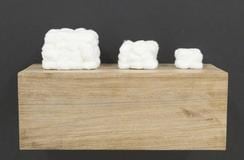
Hassan Sharif: Isabelle van den Eynde
January 18 – March 3, 2016
Image: White Cube No 1, 2015
Hassan Sharif included in the exhibition White Cube… Literally: On form and convention of display curated by Amanda Abi Khalil, at Gallery Isabelle van den Eynde, Dubai.
The ideal gallery subtracts from the artwork all cues that interfere with the fact that it is “art”. The work is isolated from everything that would detract from its own evaluation of itself. This gives the space a presence possessed by other spaces where conventions are preserved through the repetition of a closed system of values. Some of the sanctity of the church, the formality of the courtroom, the mystique of the experimental laboratory joins with chic design to produce a unique chamber of aesthetics.
Brian O’Doherty, “Inside the White Cube”
There is a possibility that White Cube… Literally is the result of a simple curatorial exercise that consists of gathering artworks around a common form (the cube) and colour (white) – an anthology of white cubes in an immaculate white cube gallery located within a hub of white cube spaces in Dubai. This anecdote and seemingly direct gesture addresses a rather complex and controversial ideology related to the notion of the white cube, as a form of art display stapled to modern art and exhibition-making of the last century. The curatorial challenge is to attempt to foster this debate in Dubai through a formal proposition, which is only in appearance.
The exhibition takes the white cube form as a playful terrain to challenge the 'reduction of artworks to their formal aspects' when it comes to a display inside the white cube. This series of white cubes ranges from conceptual, post-conceptual, minimal and post-minimal works to contemporary practices, and includes newly-commissioned works and iconic contributions from the mid-20th century. A documentation space inside the gallery is dedicated to the discursive material around the notion of the white cube.
The white cube grants an appearance of eternality and unchangingness to artworks, and has become a recurring convention of the gallery space, circumscribing its influences on the history of museum display, curatorial practice and foremost, art history. It was Alfred H. Barr in his career as Director of the Museum of Modern Art in New York and particularly with his 1936 exhibition, Cubism and Abstract Art, that the style and ideology of the white cube space was set: a formal approach toward art and exhibition development in which artworks stand autonomously and de-contextualised in a pristine environment. Since then, the white cube space has been largely criticised and accused of the elitist, commercial, out-dated and illusionary tendencies of the art world.
Few art-related essays were collected, translated and discussed as extensively as Brian O’Doherty’s Inside the White Cube, published initially as a series of three articles in Artforum in 1976. It was later assembled into a book with the subtitle Ideology of the gallery space, in which he questions the relationship between the social, economic and aesthetic value of art as represented in the white cube, raising a fundamental interrogation on artistic practices in relation to the exhibition space and its systems.
Approached individually, each work in White Cube… Literally carries its own narrative, specific discourse and concept; yet, together the works highlight unanticipated conceptual or material similarities beyond their common formal manifestation of a white cubic geometry. The works of modern and contemporary artists, stemming from western and non-western practices, delve into an array of topics, materials, cultural and historical movements beyond form, consequently underlining aesthetic conversations across disciplines, backgrounds and the context of production.
With the tendency of curatorial practice today to explore spaces beyond the conventional walls of a gallery or museum and their context-responsive display emerges a question about the possibility of analyzing the gallery space from within its own walls.